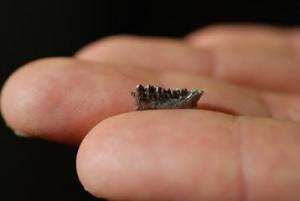 A creature that could fit in your hand has long been seen as the strongest evidence that humans and apes originated in Africa. But now scientists say 50-million-year-old Algeripithecus was not an ape or human ancestor and was more like today's lemurs, after all.
A creature that could fit in your hand has long been seen as the strongest evidence that humans and apes originated in Africa. But now scientists say 50-million-year-old Algeripithecus was not an ape or human ancestor and was more like today's lemurs, after all.
What's more, a new study of the 3-ounce (85-gram) fossil species could add weight to the idea that our earliest ancestors arose not in Africa but in Asia. Discovered in 1992 in what is now northern Africa, Algeripithecus is considered to be the oldest known ape ancestor on that continent. But the new analysis suggests the creature belonged to another ancient primate group, the crown strepsirhines. Crown strepsirhines, which are not in the human ancestry, gave rise to modern-day lemurs, galagos, and lorises (see a loris picture).
Oldest Human Ancestors From Asia?
Asia is the only other known region where ape ancestors have been found. Whether apes arose there or in Africa is a "hotly contested issue" in the study of ancient primates, the study says.
The Africa theory rests heavily on Algeripithecus, now apparently exposed as a non-ape ancestor. Other than Africa, Asia is the most logical ape-ancestor "birthplace," study leader Rodolphe Tabuce, of France's University of Montpellier, said in an email. But evolutionary anthropologist Blythe Williams said "absence of evidence" is not enough to lend credence to an out-of-Asia theory.
After all, no one knows what evidence may still linger beneath African ground.
"It's quite possible that we haven't looked in the right places or that the sediments that would have preserved that portion of the fossil record no longer exist," said Williams, of Duke University, who was not involved in the study. But she does agree that Tabuce and colleagues' research weakens the case for an African origin.
Toothcomb Technicality
Algeripithecus fossils were first found in 1992 by researchers from France's University of Montpellier at the Glib Zegdou site in northeastern Algeria. The French team has continued to unearth new, and more Algeripithecus fossils, notably skull fragments and jawbones, some nearly complete.
The jaw and skull of Algeripithecus lack classic features of anthropoids, which include monkeys, apes, and humans, according to the study, published in the September 9 issue of the journal Proceedings of the Royal Society B. Instead, Algeripithecus's jawbone has a long, thin formation, which the study says is "entirely compatible" with a "toothcomb," comblike lower front teeth used for grooming—common in strepsirhines, including modern lemurs.
Despite the new evidence, Algeripithecus is still a crucial figure in early primate evolution—but instead as one of the oldest known examples of a crown strepsirhine, the study says. Duke's Williams said the study's findings are helpful for scientists tracing how apes became human. The new study, she added, does "focus our attention on Asia"—though it's impossible to say yet if apes originated there.
Source : here
Tuesday, November 3, 2009
Algeripithecus was not a Human Ancestor
Labels: Human Phenomena
Posted by besar at 9:53 PM
Subscribe to:
Post Comments (Atom)


0 comments:
Post a Comment